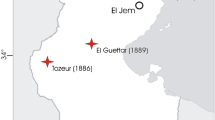Abstract
This study tackles a set of conclusions and involves an evaluation of presumptive historical earthquakes in the Eastern Mediterranean Region, which hit the region and strongly affected the archeological sites in Jordan. Actually, the core of the study was the ancient cities of Umm Qais (Gadara), Umm Al-Jimal, Deir Al-Kahf, Al-Azraq, and Pella in the North and Dhahil water reservoir and Humaima in the South. The archeological excavations made during the past 20 years helped a lot of the region’s seismicity re-evaluation and relocation of historical earthquakes, about which the researchers argued on determining their epicenters and magnitudes. The recent excavations at Umm Qais (Gadara) indicated that earthquake-impacted ruins have been buried under nearly 2 m of dust deposits for centuries. So, such important indicators that can be relied upon to determine the epicenter and magnitude evaluation of these historical earthquakes were unveiled. Based on the recent available excavations, it is obvious that Umm Qais was affected by two seismic events within a time interval of not less than 100 years. In the light of the results found in Umm Qais and the remote archeological sites of Umm Al-Jimal and Deir Al-Kahf, there was no azimuthal projection of neither collapsed nor tilted columns indicating that there was a major earthquake with the epicenter located in the Carmel rupture zone in the North of Palestine, and not in the rift zone as reported earlier. But, the second earthquake was at the northwest of Umm Qais. The earthquake reported here seems to coincide with the reported major earthquake in 748 AD while the second one that occurred earlier corresponds to the 551 AD. The eastward collapsed towers in the South with respect to the southern archeological site of Humaima and a seismic swarm in Sep. 20, 2003, suggested that the Wadi Araba fault may not be continuous but segmented, subject to confirmation by detailed sub-surface structural information.









Similar content being viewed by others
References
Al-Fryouai AA (1984) Al-Suyuti Jalal Ed-Din. Kashf Al-Salsala fi Wasf Al-Zalzala (Al-Dar Library), Al-Madineh Al-Mounawara, Saudi Arabia
Ambraseys et al (1994) The seismicity of Egypt, Arabia and the Red Sea, a historical review. Cambridge University Press, p 30
Bender F (1975) Geology of the Arabian Peninsula, Jordan. USGS. Geological Survey Professional Paper 560-I
Darawcheh R, Sbeinati MR, Margottini C, Paolini S (2000) The 9 July 551 A. D. Beirut earthquake, Eastern Mediterranean Region. J Earthq Eng 4(4):403–414. https://doi.org/10.1080/13632460009350377
Guidoboni E, Comastri A, Traina G (1994) Catalogue of ancient earthquakes in the Mediterranean area up to the 10th century, Instituto Nazionale di Geofisica
Hall JK (1996) Digital topography and bathymetry of the area of the Dead Sea depression. Int J Geotectonics Geol Phys Interior Earth Tectonophysics 266(1996):177–185
Homes Fredericq, Hennessy JB (1989) Archaeology of Jordan II2, Field reports. Leuven
Ibn Tagri Birdi (1932) Al-Nujum Al-Zahira fi Muluk Misr Wa’l-Qahira, Cairo, Egypt
Klinger Y (1999) Sismotectonique de la faille du Levant, Institut de Physique du Globe, UMR 7516. Ecole et Observatoire des Sciences de la Terre, Université Louis Pasteur-Strasbourg I. 5, rue Rene Descartes, 67084 Strasnourg, France.
Klinger Y, Avouac JP, Dorbath L, Karaki NA, Tisnerat N (2000) Seismic behavior of the Dead Sea along Araba Valley, Jordan. Geophys J Int 142(3):769–782. https://doi.org/10.1046/j.1365-246x.2000.00166.x
Le Béon M, Klinger Y, Mériaux AS, al-Qaryouti M, Finkel RC, Mayyas O, Tapponnier P (2012) Quaternary morphotectonic mapping of the Wadi Araba and implications for the tectonic activity of the southern Dead Sea fault. Tectonics 31(5):TC5003. https://doi.org/10.1029/2012TC003112
Menahem B (1979) Earthquake catalogue for the Middle East (92 B. C. To 1980 A. D.) Boll Geofis Teor Appl 21:245–313
Michael the Syrian (1899) Chronicle translated by J. B. Chabot, 4 volu., Paris, France
Raikes T.D (1985) The character of Wadi Araba, S. H. A. J., II, Amman
Samir R et al (2004) Ancient earthquakes from some Arabic sources & catalogue of Middle East historical earthquakes. p 18
Sbeinati MR et al (2005) The historical earthquakes of Syria: an analysis of large and moderate earthquakes from 1365 BC to 1900 AD. Ann Geophys 48(3)
Shahrazad A, Stephan K (2009) Geomorphology of Lake Lisan terraces along the eastern coast of the Dead Sea, Jordan. 2009 Elsevier B.V. Geomorphology 108:246–263
Acknowledgments
The author wishes to express his sincere thanks to Bassam Al-Tarawneh, the Director of Geology, Tawfiq Al Jazjeen, the Head of the Department of the Jordan Seismological Observatory. It is also a pleasure to express my gratitude to Lalliana Maulchin, the General Secretary of the International Seismic Safety Organization (ISSO), Dejanka and Steve Bryant from the UK, Nur Safadi of the Safadi Surveying and Mapping Services from Palestine, Glenda Besana Ostman from the U.S. Department of the Interior, and Waleed Olimat and Waleed Hijazeen, of the Jordan Seismological Observatory.
Author information
Authors and Affiliations
Corresponding author
Rights and permissions
About this article
Cite this article
Fandi, M. Effects of large historical earthquakes on archeological structures in Jordan. Arab J Geosci 11, 9 (2018). https://doi.org/10.1007/s12517-017-3364-7
Received:
Accepted:
Published:
DOI: https://doi.org/10.1007/s12517-017-3364-7




